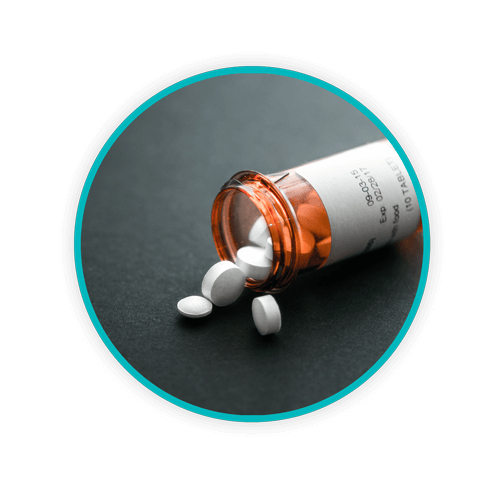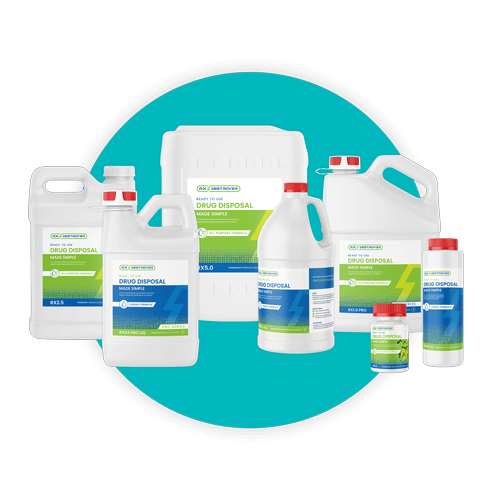Controlled Substance Disposal in Canada

Proper, safe, and compliant destruction of controlled substances throughout Canadian provinces and territories is essential, not only environmentally, but in regard to public health and wellness. Guidance documents provided by Health Canada are “must-reads” for all forms of healthcare and medical delivery services, from care homes to pharmaceutical businesses to hospitals and clinics large or small.
Failure to comply with federal guidelines when it comes to disposal of controlled substances not only increases the risk of damage to the environment but is dangerous to healthcare providers as well as the general public. Non-compliance also increases the potential for fines, penalties, and damage to reputation.
TOPICS WE WILL COVER:
1 / Guidelines for controlled substance disposal
2 / Destroying controlled substances
3 / Witnessed vs. Non witnessed destruction
5 / Denaturing products and services
6 / Safe and effective pharmaceutical waste management
Guidelines for controlled substance disposal
There are several sources of information regarding disposal of controlled substances in Canada. Start with the guidance document from Health Canada titled “Destruction of Narcotics, Controlled and Restricted Drugs and Targeted Substances by Licensed Dealers,” which was most recently updated in May 2022 as of the time of this writing.
Another valuable source of information is the Controlled Drugs and Substances Act (CDSA), which specifically targets substances that may alter mental acuity or prove to be an enhanced risk for drug diversion and misuse. It should be noted that the CDSA groups controlled substances into schedules I through V in regard to regulatory processes.
Also refer to governmental web pages regarding Regulating Controlled Substances and Precursors and look to local provincial or territory guidelines for exemption guidelines. As an example, a recent (2021) Controlled drugs and substances exemption guidelines document from Alberta’s College of Pharmacy.
A general overview of Canada’s drug scheduling guidelines are found on the National Association of Pharmacy Regulatory Authorities (NAPRA) website.
Destroying controlled substances
Controlled substance disposal requires knowledge of destruction practices. Independent pharmacies as well as those found in hospitals throughout the country are encouraged to carefully review Section 3.0 of the Destruction of Narcotics guide, which provides key information such as the difference between witnessed and unwitnessed destruction requirements and requirements for different methods of destruction like incineration and denaturation.
Licensed dealers gain authorization from regional controlled substances programs, but it is also the responsibility of such entities to ensure that not only provincial and territorial, but federal guidelines are followed in regard to environmental legislation and in preventing health hazards.
Controlled substances may not be destroyed until authorisation has been received from the regional Controlled Substances Program (CSP) following a submitted application to regional offices upon scheduling such destruction. The application must include the following information: the method of destruction, date and time, and list of products to be destroyed along with witnesses. Such details are not to be altered from the time authorisation has been granted until destruction is complete.
Pharmaceutical waste is to be clearly identified in compliant and approved pharmaceutical containers. Pharmaceuticals are generally disposed of through incineration processes, or through denaturing that renders harmful compounds and components into harmless and inert elements.
The difference between witnessed and non-witnessed destruction
According to the destruction of narcotics guidelines, destruction by licensed dealers of narcotics worth less than $750,000 can be done without a CSP inspector present, but after receipt of authorisation from the CSP.
If destruction of narcotics worth more than $750,000 is planned, the licensed dealer is required to contact the CSP for a witnessed destruction, with a CSP inspector being present. This must be arranged within 30 calendar days in advance of the destruction date. Licensed dealers should refer to the destruction of narcotics document for requirements and information regarding applications and approvals.
Methods of destruction for controlled substances
In Canada, several methods for the destruction of controlled substances are available. Regardless of the method of destruction, the controlled substance must be altered or denatured so that it can no longer be consumed. Two primary methods are currently approved:
- Incineration – Temperatures must reach at least 400°C in the destruction cycle.
- Denaturation – Chemical destruction can be used in locations or scenarios where incineration will not meet municipal, provincial, or federal environmental laws or may cause potential health hazards to the public during the destruction of such drugs. This method is also available when incinerators are not available or when substances are incompatible with incineration or have the potential of damaging the incinerator.
Denaturation processes may also involve a number of methods that include use of strong acids, mixing the controlled substances with halogenated or radioactive waste. At the conclusion of denaturing processes, environmental regulations for disposal must be followed. The same applies to mixing controlled substances or products by combining the process of denaturing agents with incineration of the resulting waste.
Denaturing products and services
Denaturing products and services such as Rx Destroyer, used as a joint solution with our Pharmasmart pharmaceutical waste containers, have become an increasingly popular method of denaturing controlled substances as well as reducing instances of drug diversion in healthcare and other medical scenarios.
Products like Rx Destroyer are cost-effective and provide easy solutions for reducing risks of non-compliant disposal processes of controlled substances. Such methods also reduce the risk of drugs and medications, expired or not, from falling into the wrong hands and being misappropriated. Some additional tips include:
- Witness-observed destruction of controlled substances ensures proper destruction and denaturing of unused or expired drugs and those that have been returned to pharmacies, physician’s offices, or hospitals for destruction.
- Remove medications from packaging, bubble packs, foil packets or vials before placing into an Rx Destroyer bottle. Mixing through gentle agitation creates a slurry that breaks down the components of the drugs with the liquid components of the Rx Destroyer bottle.
- Secure resulting waste (bottle or container) into a larger tub or container with a locked top prior to pick-up and disposal by a reputable pharmaceutical waste management company such as Daniels Health.
Daniels Health manufactures and produces several pharmaceutical containers that meet a variety of scenarios and volumes. Such containers cannot be reopened and are equipped with tamperproof locks while on-site and during transportation.
Safe and effective pharmaceutical waste management
Safe and effective pharmaceutical waste management is a must throughout Canada. Compliant collection, containment, and disposal of controlled substances is critical to protecting the environment, healthcare providers, and the general public as well as mitigating drug diversion potential.
Daniels Health takes a cradle-to-grave approach to all healthcare waste streams. We encourage any healthcare provider or facility, including pharmacies throughout the country, to maintain compliance by staying up to date with guidance regarding controlled substances and their disposal.
For more information about cost-effective and reliable waste program solutions and products that are not only better for the environment, but improve safety, contact Daniels Health today.
Let's Talk!
Your time is valuable, and we don’t want to play hard to get. You can either phone us directly on the details listed on our contact page, or feel free to fill out this short form and one of our team members will get back to you as quickly as possible.
